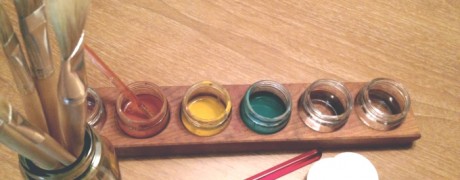Most of our paint explorations at home have been with watercolours. I love the possible complexity that watercolours can offer when the colours combine and the simplicity of clean up time.
We have practiced wet-on-wet watercolour painting, which is such a beautiful experience for little ones. Check out this video to learn more about setting up a wet-on-wet experience for your children (or yourself – it’s a good time).
A few of our favourite supplies for watercolour painting include:
- Wooden painting board (make your own or find one here)
- Good quality watercolour paper (we enjoy this brand) – for wet-on-wet, a fairly thick paper is helpful
- Nice watercolour paints – we have had these on our wish list for several years
- Brushes with coloured handles
Finally, a few quick tips that I have found helpful over the past several years:
- We often use brushes with coloured handles so that smaller children can easily see which paintbrush belongs in each jar, and it really helps the colours to stay true rather than mix until they turn brown. If the kids want to mix colours, we add in some empty containers and plain brushes.
- If you’re starting out with quite little ones, I’ve read that it’s good to start out with just one colour and to let them fully explore that colour before adding another. Putting out the primary colours and some empty containers for mixing is also a great way to encourage children of all ages to create new shades.
- Good quality supplies are worth the investment. They do create much more beautiful products, and often a more enjoyable experience. Quality products often cost more, though they truly last longer.
- We make a habit of keeping art supplies accessible, so the kids don’t have to wait for an adult to get the supplies for them, and they can take some ownership over caring for them.
- Kids are sometimes more open to letting loose creatively, when an adult they love and trust is sitting at the table with them, getting their art on. You don’t have to be great. You don’t even have to be good. Just let your kids see you in the creative process. Let them see your mistakes. Let them see that it’s about enjoying the process, not fretting over the product.



